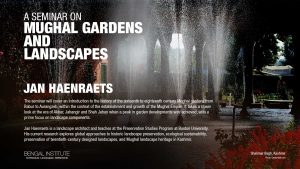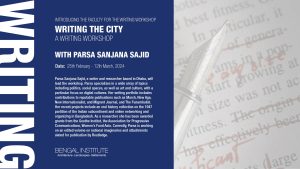
Spring 2020: An Archaeology of Modernism
Mon 10 Feb - Mon 20 Apr' 20
The role of modernity in the making of architecture in Bengal, and the nature of architectural modernism itself are topics that need a better understanding. This sequence will have three sessions focusing on some of the core philosophies of modernism.
The role of modernity in the making of architecture in Bangladesh, and the nature of architectural modernism itself are topics that need a better understanding. About hundred years ago, in Europe, a group of architects, artists, writers and designers created a radical body of work that defined the practice and production of architecture for the next century and beyond. While many turns and twists, and counter narratives have emerged since then, the legacy of modernism endures.
Bengal Institute offers for the first time a comprehensive academic program on the topic. A wide group of scholars, academic and architects will contribute to the program. The presentations and discussions will benefit young scholars, faculty, and anyone interested in the broad topic of modernity in Bengal.
It is quite remarkable that two major events define and give foundation to modern architecture in Bangladesh: a modern ethos and spirit defined by the persona of Muzharul Islam, and the monumental turning point ushered in Dhaka by Louis Kahn. At the same point architects like Paul Rudolph, Constantinos Doxiadis, Robert Bouighy, Stanley Tigerman and others created a series of emulative projects representative a wide array of modernist production. The first architecture school in the country was established on the pedagogy of the Bauhaus.
A three-month long program will explore and analyse the modernist tradition. Events will include seminars, workshops, exhibitions, films, and site visits. Participants will be required to make analytical models and write criticisms.
February 2020 — Muzharul Islam and Bengali Modernism
Muzharul Islam is the most important and key figure in the evolution of architectural modernism in Bangladesh. An investigation of Muzharul Islam’s position and ideology requires an understanding of the political and social history of Bengal in the 19th century leading to events in then Pakistan in the 1960s. It also requires an analysis of the influences of European modernism on fine-arts and other forms of art and literature on cultural leaders in Kolkata and Dhaka. With much boldness and fortitude, Muzharul Islam established a new path of thinking, designing and building in the nineteen fifties that was an apt response to the social and political situation. There is much to learn from the connections and influences, and the social and political backgrounds that defined Islam’s determined approach and unwavering integrity which in turn produced some of the landmark works of situated modernity. Muzharul Islam’s diverse role as a professional, activist, and intellectual also defined for next generations a broad engagement between architecture and society.
The session will investigate Muzharul Islam’s work closely as well as cover the historical and cultural setting in which they were produced. Participants will have the opportunity to visit some of this works, discuss and analyse them, and produce materials for an upcoming publication.
Tentative List of Faculty: [On chronology of topics]
– Kazi Khaleed Ashraf (Introduction to Muzharul Islam, and analysis of his work and ideology)
– Sonia Amin (Modernity in Bengal: a social perspective).
– Farhan S. Karim (Doxiadis and developmental architecture in then East Pakistan)
– Shamsul Wares (Muzharul Islam’s life and work in the context of then East Pakistan)
– Taufique Rahman Khan (The political context of 1947 and early Bangladeshi modernism)
– Nurur Rahman Khan (Muzharul Islam’s personal philosophies and ideologies)
– Saif Ul Haque (Chetana Society activities, and Muzharul Islam’s influence on later architecture of Bangladesh)
– Rezaul Karim Sumon (Novera Ahmed and modern art in Bangladesh)
– Niklaus Graber (Muzharul Islam in an international perspective)
Tentative date: 10th to 20th February, 2020
Activities:
– Seminars
– Visit to Muzharul Islam Archives at University of Asia Pacific
– Visits to Muzharul Islam’s projects within and on the outskirts of Dhaka
– Analytical model making and written papers
March 2020 ー Bauhaus and Early Modernism
Bauhaus played a catalytic and fundamental role in the development of European Modernism which eventually was to have a decisive influence all over. Despite lasting for only fourteen years in Germany, Bauhaus became the most influential art and design school which led to re-thinking architectural and artistic work within industrial production for a mass populace, and in a radical integration of all the disciplines of art and architecture. Founded by Walter Gropius in 1919 in a post-WWI era Weimar Republic, the school has had tremendous influence globally in the fields of art, architecture and design.
The March Session, along with an exhibition, will focus on the impact of the Bauhaus, its historical development, and subsequently, early modernism in architecture and design related fields.
To celebrate the centenary of the Bauhaus, Goethe Institute Bangladesh in partnership with Bengal Institute will also organise a traveling exhibition titled bauhaus imaginista in March. The exhibition aims to rethink the school from a global perspective and its involvement against a century of geopolitical change.
Exhibition to open on 29th March, 2020
Tentative date for academic program: 23rd March to 2nd April, 2020.
Tentative List of Faculty:
– Kazi Khaleed Ashraf [On Corbusier and Mies]
– Saif Ul Haque [on Alvar Alto]
– Anshuman Dasgupta [Shantiniketan and Bauhaus]
– Syeda Tuhin Ara (Aupee) Karim [directing a Bauhaus style small theatre]
– Diane Taylor [on modern furniture design practices]
– Riyaz Tayyibji [on Gandhi and his distinctive modernity]
– Shamsul Wares [on the early history of Bauhaus influence in Bengal art scene]
April 2020 ー Kahn: The Turning Point
Deeply rooted in a historical consciousness, with a profound sense of humanism and poised for reorientations of the fundamentals of architecture, Louis Kahn was the most significant architectural phenomenon of the 1950s and 60s. Kahn’s work and ideas brought new dimensions in design thinking and practice, as well as architectural discourse. His works exemplified Late Modernism, and as some would argue, ushered “postmodernism” in architecture. His philosophical thinking was grounds for a fundamental revision of architecture. Followed by Muzharul Islam’s initiatives, Louis Kahn’s presence in South Asia had a lasting impact on the practice of architecture in Bangladesh but again not deeply analysed.
To understand Kahn’s work and ideas, the April academic program will include seminars and discussions with academics, architects and experts who have researched and studied about Kahn, his works and his philosophy.
Tentative Date: 12th to 23rd April, 2020
Tentative List of Faculty:
– Kazi Khaleed Ashraf
– Jaimini Mehta
– Shilpa Mehta
– Marina Tabassum
– William Whitaker
Activities:
– Seminars
– Public Lectures
– Visit to Sher-E-Bangla Nagar to see the Parliament Complex and surrounding area.
As usual, the academic programs are open for anyone with a bachelor’s degree or a final-year undergraduate studentship from any discipline to attend (subject to application, selection and payment). We will open the application very soon; meanwhile go through the details, mark and clear your calendar. You will be able to sign up for all three sessions together or individually. Feel free to ask questions in the comment or write to [email protected]
Upcoming Program
Past Program
Publication





